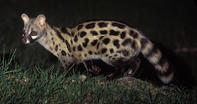
Small-Spotted Genet
Name
Small-spotted Genet – also known as Common Genet [Genetta genetta]
Small-Spotted Genet Appearance
The small-spotted genet, as its name implies, is smaller than the large spotted genet of South Africa. The markings on the small genet’s coat are a distinct white and black, with no rusty tinge and it has a white tipped tail. The black spots on the body form strong lines as it spreads towards the tail.
Erectile black hairs can be seen along the spine and it has a black and white ringed tail. Their faces have distinct white patches below the eye area and they possess sharp retractile claws.
Small-Spotted Genet Diet
The small-spotted genet mainly eats smaller mammals and insects. Other foods sources include bats, birds, reptiles, amphibians, millipedes, centipedes and scorpions indigenous to South Africa.
Small-Spotted Genet Breeding
In South Africa, the small-spotted genet produces two litters per year. Litters comprise of between two to three young with a gestation period of between 70-77 days. The young first open their eyes and ears after around 5-18 days. The canines appear within one month, after which they will begin to eat solid food while continuing to suckle for many months.
Small-Spotted Genet Behaviour
The small-spotted genet is solitary in nature and can be found resting during the day in holes in the ground, rocky areas or up in the trees, although they are less arboreal than the large spotted genet. They prefer to live in dry woodland areas but can also be found in riverine environments.
Where they are found
The small-spotted genet prefers the drier regions found inland of South Africa. They do not inhabit the west coastal regions of Namibia and South Africa.
Field Notes
The small-spotted genet often becomes tame around safari camps and is not shy to climb upon tables and investigate the food at meal times.

Learning about the mammals of South Africa is now so much easier for all South Africans - SouthAfrica.co.za is an excellent source of inform...
more
